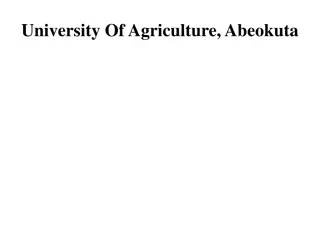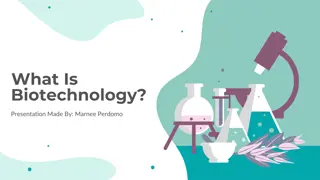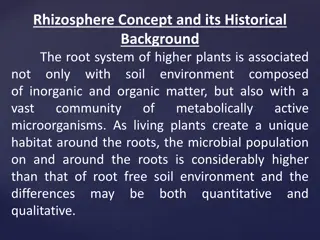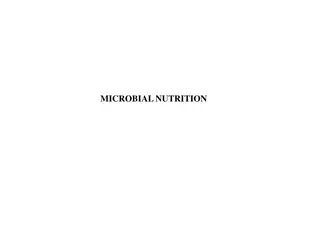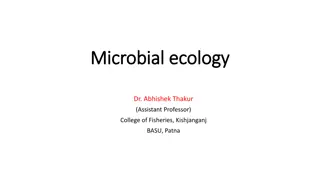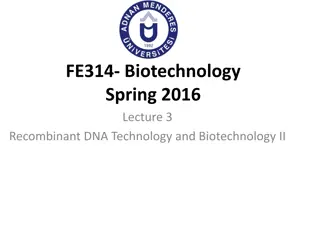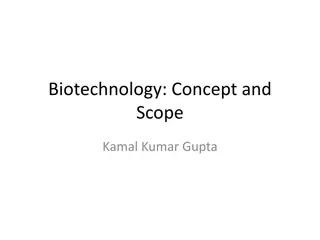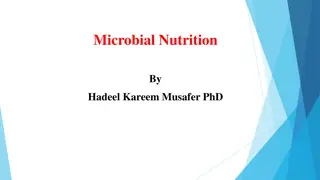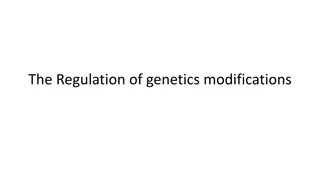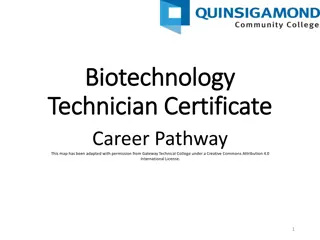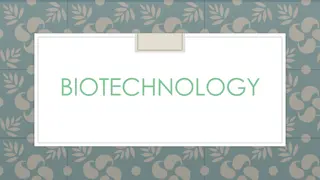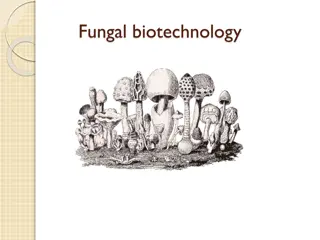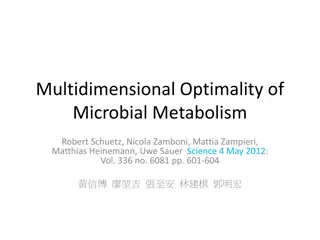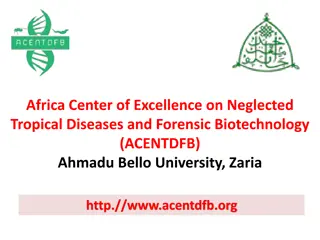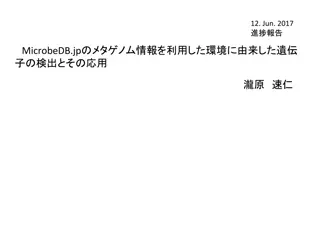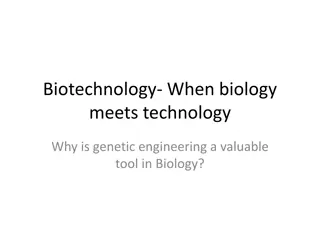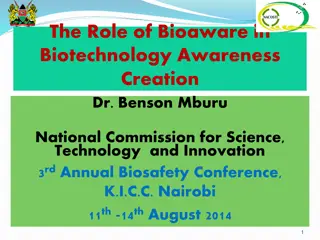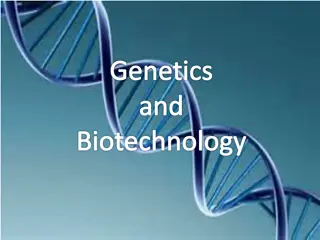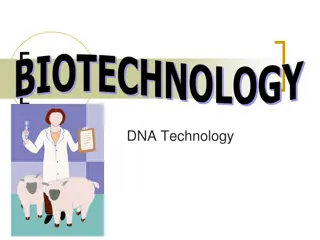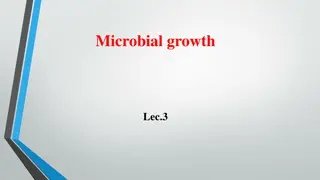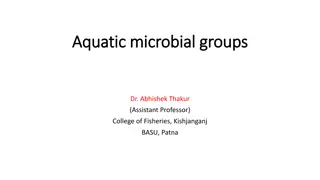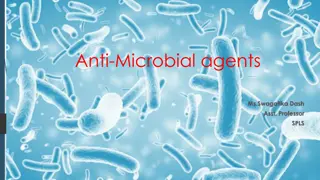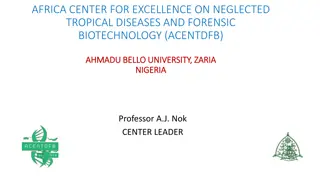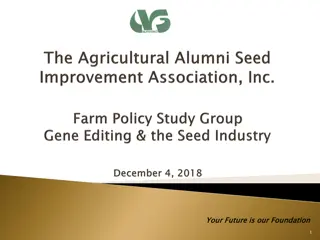Introduction to Biotechnology in Pharmaceutical Sciences: A Comprehensive Overview by Swarnakshi Upadhyay
Biotechnology in pharmaceutical sciences encompasses the application of scientific and engineering principles to utilize biological agents for various services. It includes molecular biology for production of pharmaceuticals like antibiotics, proteins, and enzymes, as well as large-scale production
0 views • 9 slides
Overview of Industrial Biochemistry and Biotechnology
This course outline covers key topics in industrial biochemistry, microbiology, and biotechnology, focusing on the use of microorganisms and molecules to achieve specific goals in production processes. It delves into microbial physiology, genetics, metabolic pathways, enzymes, microbial growth, ferm
0 views • 10 slides
Exploring Biotechnology in Agriculture at University of Abeokuta
Delve into the world of Biotechnology at the University of Agriculture in Abeokuta, where students are equipped with interdisciplinary knowledge to apply microorganisms for practical applications in society. The course, led by Prof. I. Akpan and Dr. F. Oluwafemi, aims to broaden students' understand
0 views • 61 slides
Understanding Biotechnology: A Comprehensive Overview
Biotechnology is the application of technology based on biology, utilizing living organisms and molecular biology to create healthcare products. It involves studying the functionality of living organisms by combining biology, physics, chemistry, mathematics, and technology. Careers in biotechnology
2 views • 8 slides
Ongoing USDA Programs and Biotechnology Research Overview
This overview delves into ongoing USDA programs such as the Biotechnology Risk Assessment Grants (BRAG) Program, which supports biotechnology research. The program covers risk assessment, management, pollen flow research, gene transfer control methods, and more. Additionally, voluntary market facili
0 views • 16 slides
Understanding the Rhizosphere: A Historical and Microbial Perspective
The rhizosphere, the region surrounding plant roots, harbors a diverse community of microorganisms influenced by plant roots. Historical background and microbial interactions in the rhizosphere are explored, highlighting the favorable habitat for microbial proliferation and metabolism. Various techn
1 views • 49 slides
Understanding Microbial Nutrition and Bacterial Physiology
Microbial nutrition involves essential elements required for microbial growth and energy production. Bacterial physiology delves into the structures and functions that enable bacteria to thrive, from cell wall composition to enzyme activities. Major elements like C, O, H, N, S, and P are crucial for
2 views • 20 slides
Understanding Microbial Nutrition and Growth Factors
Microbes require carbon for metabolic activities, with organisms categorized as heterotrophs or autotrophs based on their carbon source. In addition to carbon, macronutrients like nitrogen, phosphorous, sulfur, potassium, and magnesium are crucial for cell function. Growth factors such as amino acid
0 views • 15 slides
Understanding Microbial Genetics and Mutations in Organisms
Explore the world of microbial genetics with Dr. Abhishek Thakur, an Assistant Professor specializing in Microbial Genetics at the College of Fisheries, Kishjanganj, BASU, Patna. Learn about important concepts such as strains, clones, genome, phenotype, genotype, genes, genetic recombination, and mu
1 views • 19 slides
Methods for Determination of Microbial Growth
Quantitative determination of microbial growth is crucial for various purposes, with two commonly used methods being the standard plate count and spectrophotometric measurement. The standard plate count method estimates living microbial cell density, while spectrophotometric measurement relies on tu
2 views • 6 slides
Understanding Microbial Ecology: Interactions and Associations in Ecosystems
Interactions of organisms in ecosystems play a crucial role in the functioning of microbial ecology. Dr. Abhishek Thakur explores symbiosis, mutualism, syntrophism, commensalism, predation, and parasitism, shedding light on how different organisms interact with each other and their physical environm
0 views • 9 slides
Mechanisms of Nutrient Uptake by Microbial Cells
Nutrient uptake by microbial cells involves various transport mechanisms such as passive diffusion, facilitated diffusion, active transport, and group translocation. These mechanisms ensure the specific acquisition of required nutrients by the cell through the selectively permeable plasma membrane.
3 views • 15 slides
Applications of Recombinant DNA Technology in Biotechnology
Explore the various applications of recombinant DNA technology in biotechnology, including insulin production for diabetes, enzyme production in food biotechnology, and the development of Golden Rice. Understand the process of insulin production using recombinant DNA technology and the significance
0 views • 32 slides
Genetic Manipulation in Environmental Biotechnology
Genetic manipulation strategies in environmental biotechnology involve techniques like gene splicing and molecular cloning to modify genes directly. These methods have various applications such as isolating genes, producing specific molecules, improving biochemical production, creating organisms wit
0 views • 20 slides
Insights into Biotechnology: Concepts and Applications
Biotechnology involves the application of scientific and engineering principles to utilize biological agents for producing goods and services. The field encompasses processes like upstream processing, fermentation, and downstream processing to create valuable compounds. Initially, efforts focused on
0 views • 22 slides
Understanding the Normal Microbial Flora of the Human Body
The normal microbial flora, also known as the indigenous microbiota, inhabit various areas of the human body such as the gastrointestinal tract, respiratory tract, genitourinary tract, and skin. They play a crucial role in maintaining health and can re-establish themselves when disturbed. While resi
0 views • 22 slides
Understanding Microbial Nutrition and Essential Elements
Microbial nutrition is crucial for the growth and functioning of microorganisms, requiring various elements in different quantities to construct cellular components and obtain energy. Major elements like carbon, oxygen, hydrogen, nitrogen, sulfur, phosphorus, and others play vital roles in microbial
0 views • 20 slides
The Regulation of Genetics Modifications in Biotechnology
Biotechnology plays a significant role in engineering plants and regulating food crops through genetic modifications. The use of modern biotechnology, such as genetically modified organisms (GMOs), has grown exponentially worldwide. Advantages include increased agricultural productivity and improved
0 views • 11 slides
Biotechnology Technician Certificate Program Overview
The Biotechnology Technician certificate program offers an insight into the science and technical skills required for a career in biotechnology. Graduates gain essential laboratory skills, scientific knowledge, and critical thinking abilities to work effectively in the industry. The curriculum cover
1 views • 9 slides
Factors Affecting Microbial Growth in Foods
Moisture content and pH levels are key factors influencing the growth and survival of microorganisms in foods. The water activity (aw) of food substrates affects microbial growth, with bacteria and fungi having varying requirements. Lowering aw below optimum levels can increase the lag phase of grow
2 views • 15 slides
Advances in Biotechnology: Transforming Health, Environment, and Science
The 21st century is witnessing remarkable progress in biotechnology, with significant discoveries shaping the fields of health, environment, and science. From the introduction of penicillin antibiotics to the creation of transgenic organisms, biotechnology continues to pave the way for innovative so
0 views • 17 slides
Understanding Biotechnology: Techniques, Definitions, and Applications
Biotechnology involves the use of living organisms or their components to develop products in various fields like Industry, Agriculture, Medicine, and Food Processing. It integrates biochemistry, microbiology, and engineering sciences for industrial applications, including genetic engineering to cre
2 views • 27 slides
Exploring the World of Fungal Biotechnology
Fungal biotechnology involves utilizing living organisms like fungi for industrial applications, leading to the production of various valuable products such as enzymes, vitamins, and secondary metabolites. This field not only benefits industries by offering energy-efficient processes but also contri
0 views • 15 slides
Multidimensional Optimality of Microbial Metabolism
Exploring the multidimensional optimality of microbial metabolism through metabolic network analysis, C-based flux analysis, and stoichiometric reaction modeling. The concept of Pareto optimal solutions in multi-objective optimization problems is discussed in the context of microbial metabolic pathw
0 views • 22 slides
Innovative Hygienic Solution for Healthcare Facilities: Introducing Medi-ShowerTM
Multi-Shower GB has developed the award-winning Medi-Shower, a unique anti-microbial showering system designed for healthcare facilities. Featuring color-coded Medi-Flush inserts, quarterly maintenance, and continual protection from bacteria, Medi-Shower provides a comprehensive solution to address
0 views • 11 slides
Effects of Spicy Foods on Pathogenic Microbial Growth: A Study on Rosemary and Clove
Spicy foods like rosemary and clove have shown potential in inhibiting pathogenic microbial growth, which can help enhance food safety by reducing the need for chemical additives. This study explores the antimicrobial effects of these spices using microbial strains like Pseudomonas Fluorescens and S
0 views • 14 slides
Advancing Microbiological Systems Through Genetic Engineering and Microbial Community Engineering
Exploring the intersection of genetic engineering and microbial community engineering to enhance electron bifurcation systems. Addressing trade-offs between synthetic biology and wildtype organisms, incorporating microbial community engineering in Synbio, and investigating CO2 metabolism in the abse
0 views • 8 slides
Advancing Research and Innovation in Neglected Tropical Diseases and Forensic Biotechnology at Ahmadu Bello University, Zaria
The Africa Center of Excellence on Neglected Tropical Diseases and Forensic Biotechnology (ACENTDFB) at Ahmadu Bello University in Zaria is focused on upgrading its facilities, expanding research units, and establishing advanced laboratories to address global health challenges. Strategic objectives
0 views • 11 slides
MicrobeDB Database Analysis for Microbial Diversity
In June 2017, data from MicrobeDB.jp was analyzed, revealing microbial diversity in various phyla and families. The study included Wilcoxon P-values and abundances of different microbial genera. The analysis indicated the presence of various bacterial and archaeal species in different environments,
0 views • 20 slides
Exploring Genetic Engineering and DNA Fingerprinting in Biotechnology
Discover the intersection of biology and technology through genetic engineering and biotechnology, which have revolutionized fields such as forensics, medicine, and agriculture. Learn about DNA manipulation, DNA fingerprinting processes, and how they are applied in forensic investigations and patern
0 views • 27 slides
Role of Bioaware in Biotechnology Awareness Creation
Bioaware, the national biotechnology awareness strategy hosted at NACOSTI, aims to provide a participatory mechanism for creating awareness about the role of biotechnology in Kenya's development agenda. It seeks to impart knowledge of biotechnology and its products to human health and the environmen
0 views • 16 slides
Microbial Isolation Techniques and Methods
This content provides a detailed guide on the isolation of microbes from various environments using techniques such as sample introduction, inoculation, incubation, inspection, and identification. It includes information on the use of an incubator, materials, and methods required for microbial isola
0 views • 13 slides
Principles of Food Spoilage: Understanding Microbial and Nonmicrobial Factors
Explore the principles of food spoilage in the context of microbial and nonmicrobial influences. Topics covered include classification of foods based on stability, types of agents causing spoilage, prevention practices, and the criteria for acceptability of food. Learn about microbial growth, enzyme
0 views • 19 slides
Exploring Genetics and Biotechnology Concepts
This educational content delves into various genetics and biotechnology concepts, including genotypes, DNA segments, heredity, flower color inheritance, genetic crosses, and biotechnology processes. It clarifies terms like homozygous, heterozygous, dominant alleles, DNA components, and parental trai
0 views • 31 slides
Understanding Biotechnology: From Ancient Techniques to Modern Genetic Engineering
Biotechnology is the study of utilizing tools from living organisms to develop new products and processes for the benefit of society. It encompasses ancient practices like fermentation to modern genetic engineering techniques, such as manipulating genetic information in organisms. The Human Genome P
0 views • 31 slides
Understanding Microbial Growth: Phases and Dynamics
Microbial growth is defined as an increase in cellular constituents leading to a rise in microorganism size or population. The growth of bacterial cells is characterized by distinct phases such as lag phase and exponential phase. During the lag phase, cells are synthesizing new components before div
0 views • 21 slides
Understanding Aquatic Microbial Groups and Their Environments
Explore the diverse world of aquatic microbial groups, their distribution in different water bodies, and their roles in ecosystems. Learn about the factors influencing microbial growth in water, the impact of eutrophication, bioremediation strategies, and the unique microbial communities found in es
0 views • 18 slides
Understanding Anti-Microbial Agents and Their Applications
Anti-microbial agents, including antiseptics, disinfectants, and germicides, play a crucial role in preventing infections and promoting public health. They can inhibit the growth of pathogenic micro-organisms on living tissues, objects, and materials. Sterilization ensures complete destruction of al
0 views • 16 slides
Africa Center for Excellence on Neglected Tropical Diseases and Forensic Biotechnology (ACENTDFB), Ahmadu Bello University, Zaria, Nigeria
ACENTDFB, established in 2014 at Ahmadu Bello University, Zaria, focuses on neglected tropical diseases like trypanosomiasis, onchocerciasis/filiariasis, rabies, and forensic biotechnology. The center offers postgraduate programs, including PhD and MSc in Biotechnology, and short courses on various
0 views • 24 slides
Evolution of Biotechnology in Agriculture: Challenges and Controversies
Explore the evolution of biotechnology in agriculture through traditional plant breeding to modern genetic transformation technologies. Witness the promise of novel traits and faster breeding cycles, alongside the instant controversy and regulatory challenges faced by the industry. Discover the shif
0 views • 24 slides


